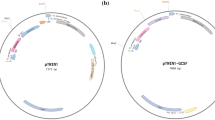Abstract
Simple procedures have been devised for purifying recombinant human interleukin-2 (hIL-2), which was expressed inEscherichia coli using sequences of glucagon molecules and enterokinase cleavage site as an N-terminus fusion partner. The insoluble aggregates of recombinant fusion protein produced inE. coli cytoplasm were easily dissolved by simple alkaline pH shift (8→12→8). Following enterokinase cleavage, the recombinant hIL-2 was finally purified by one-step reversed-phase HPLC with high purity. The ease and high efficiency of this simple purification process seem to mainly result from the role of used glucagon fusion partner, which could be applied to the production of other therapeutically important proteins.
Similar content being viewed by others
References
Henney, C. S., K. Kuribayashi, D. E. Kern, and S. Cillis (1981) Interleukin-2 augments natural killer cell activity.Nature 291: 335–338.
Farrar, W. L., H. M. Johnson, and J. J. Farrar (1981) Regulation of the production of immune interferor and cytotoxic T lymphocytes by interleukin 2.J. Immunol. 126: 1120–1125.
Lin, S. J., R. L. Roberts, B. J. Ank, O. H. Nguyen, E. K. Thomas, and E. R. Stiehm (1997) Human immunodeficiency virus (HIV) type-1 GP120-specific cell-mediated cytotoxicity (CMC) and natural killer (NK) activity in HIV-infected (HIV+) subjects: enhancement with interleukin-2 (IL-2), IL-12, and IL-15.Clin. Immunol. Immunopathol. 82: 163–173.
Liang, S. M., B. Allet, K. Rose, M. Hirschi, C. M. Liang, and D. R. Thatcher (1985) Characterization of human interleukin 2 derived fromEscherichia coli.Biochem. J. 229: 429–439.
Kim, D.-Y., J. Lee, V. Saraswat, and Y.-H. Park, Glucagon-induced self-association of recombinant proteins inEscherichia coli and affinity purification using a fragment of glucagon receptor. Manuscript submitted toBiotechnol. Bioeng.
Weir, M. P. and J. Sparks (1987) Purification and renaturation of recombinant human interleukin-2.Biochem. J. 245: 85–91.
Kato, K., T. Yamada, K. Kawahara, H. Onda, T. Asano, H. Sugino, and A. Kakinuma (1985) Purification and characterization of recombinant human interleukin-2 produced inEscherichia coli.Biochem. Biophys. Res. Comm. 130: 692–699.
Author information
Authors and Affiliations
Corresponding author
Rights and permissions
About this article
Cite this article
Won, HS., Lee, J., Kim, IH. et al. Simple purification ofEscherichia coli-derived recombinant human interleukin-2 expressed with N-terminus fusion of glucagon. Biotechnol. Bioprocess Eng. 5, 13–16 (2000). https://doi.org/10.1007/BF02932346
Received:
Accepted:
Issue Date:
DOI: https://doi.org/10.1007/BF02932346




